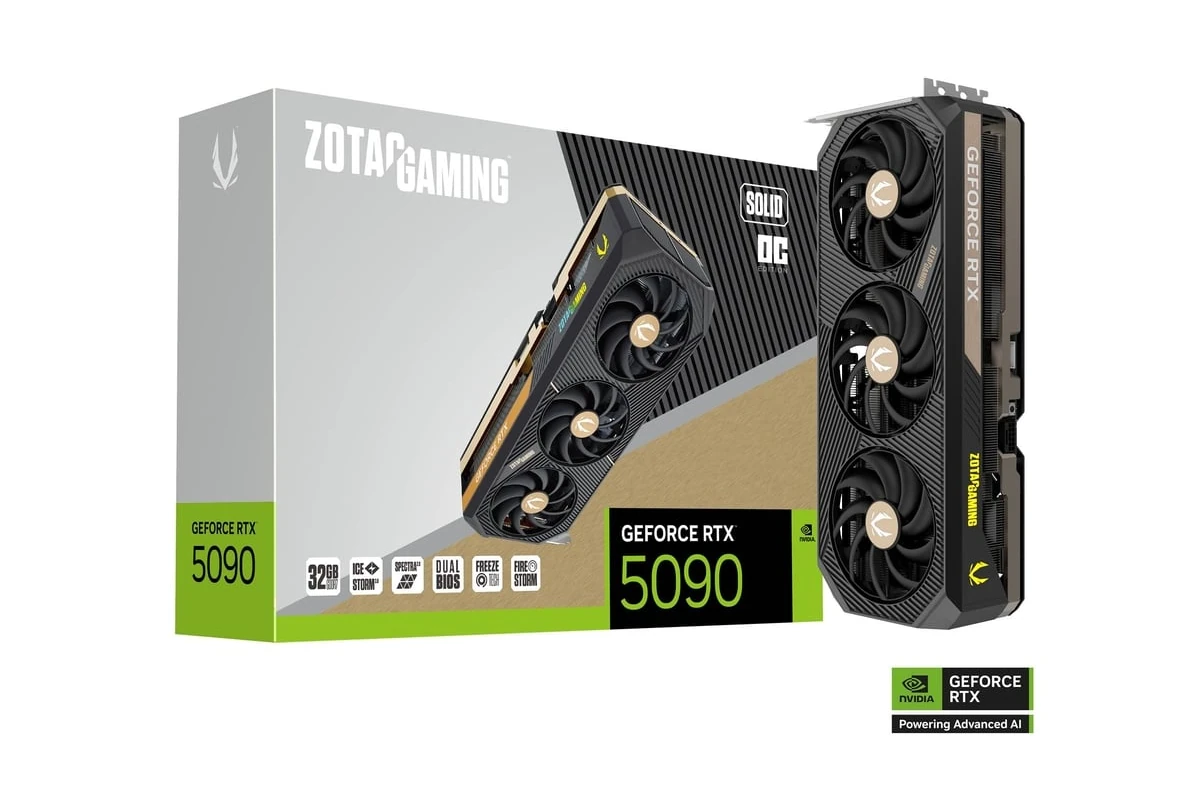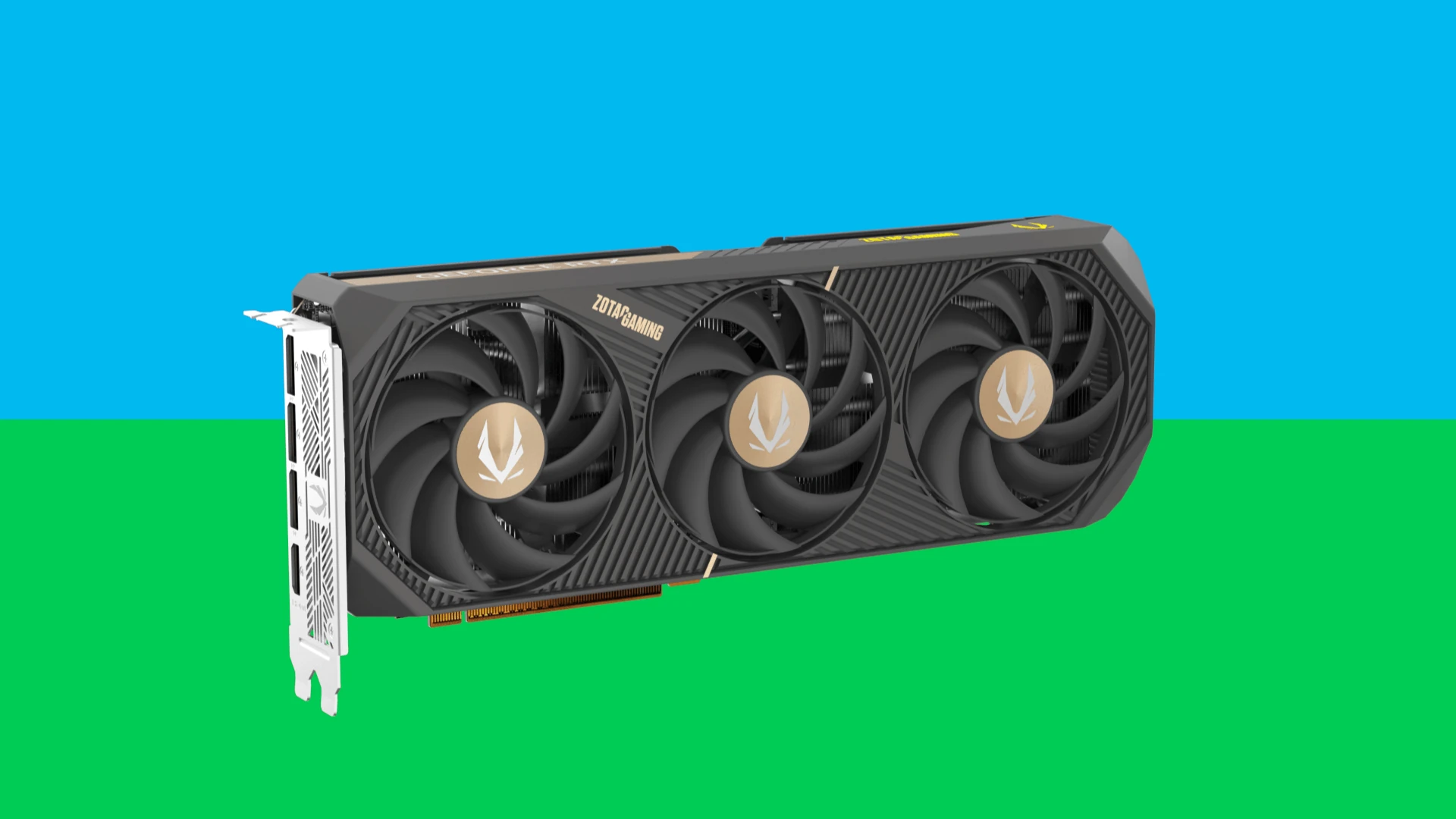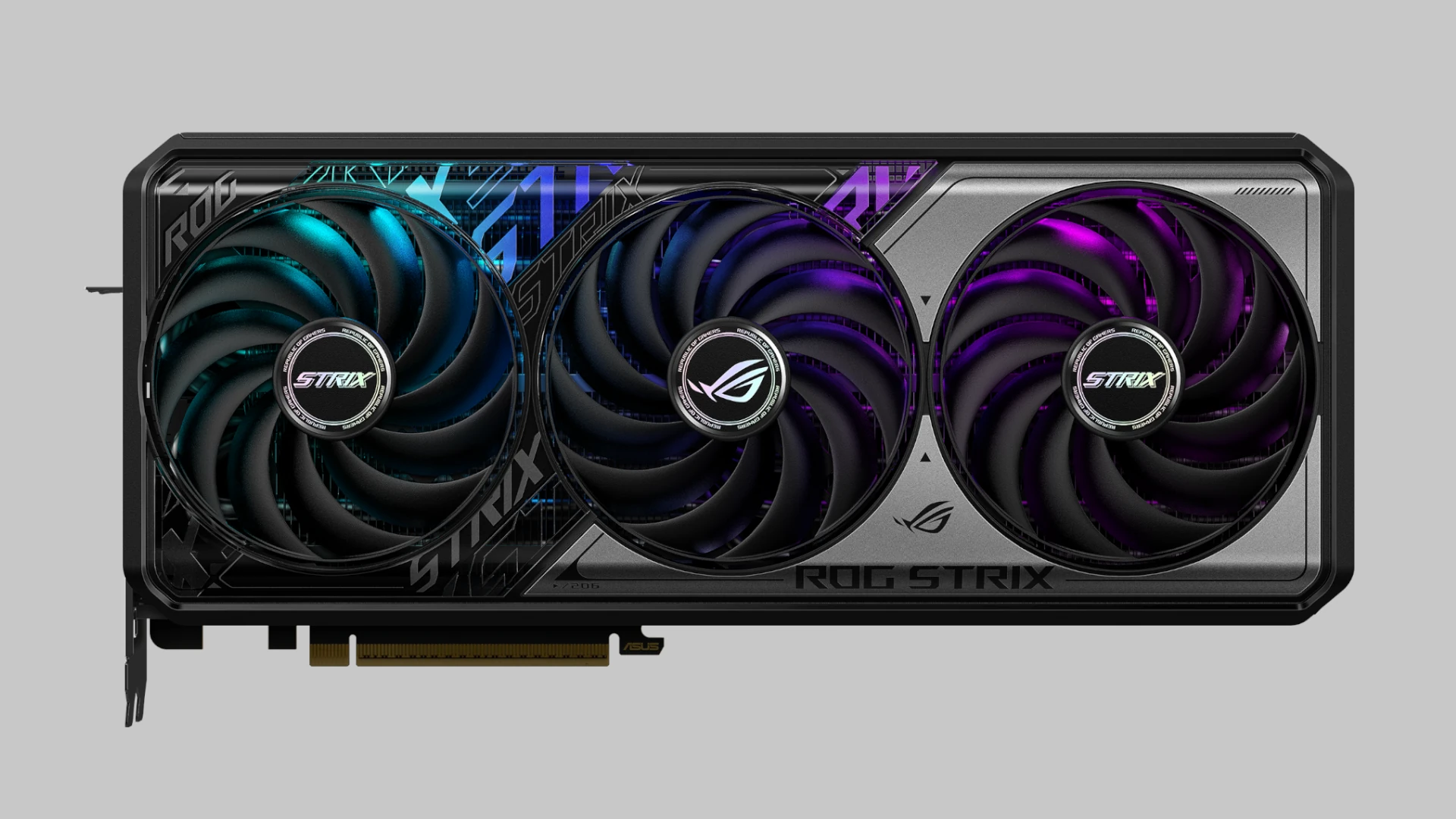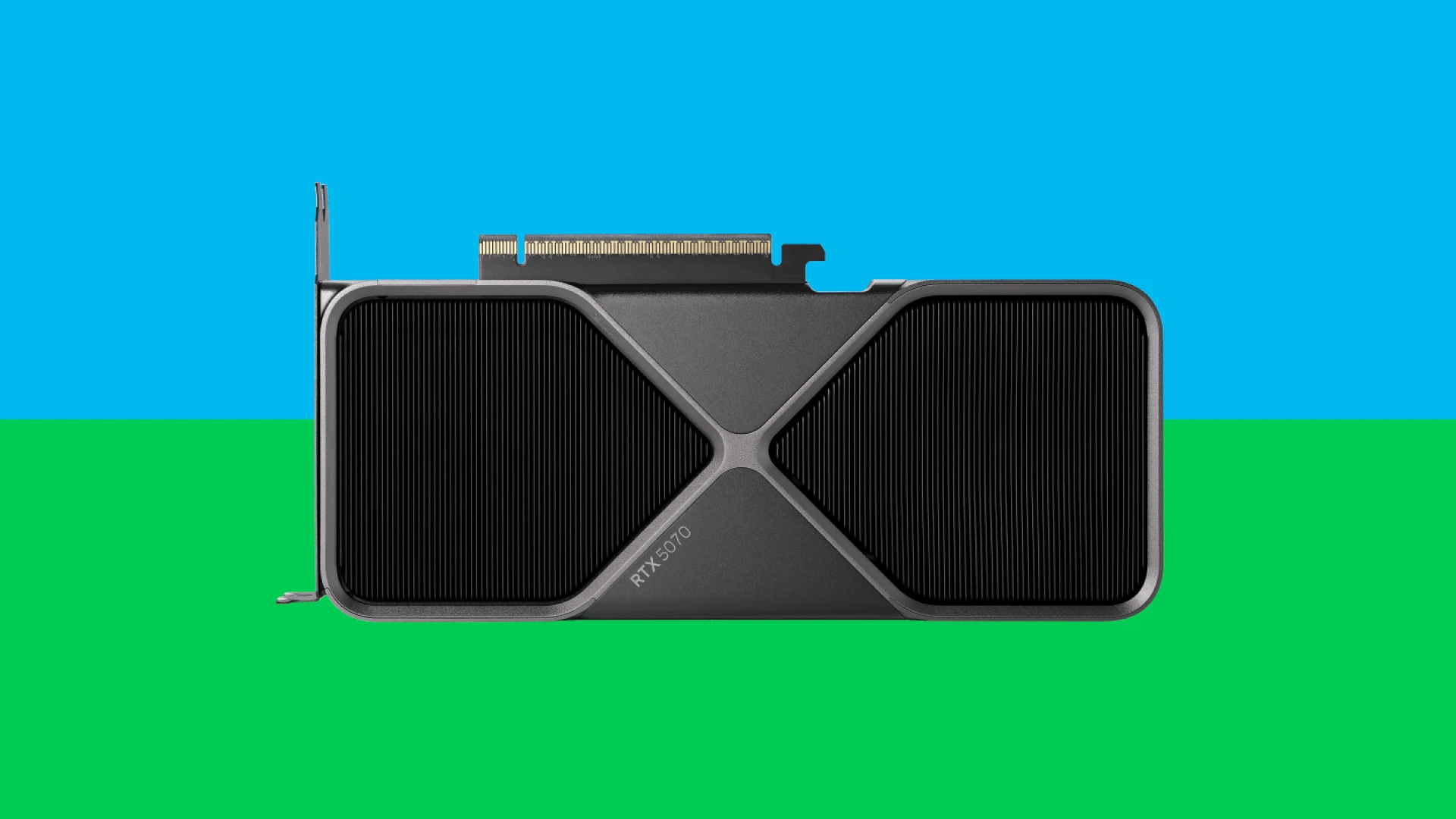Choosing the right graphics card in 2025 isn’t just about chasing the highest frame rates—it’s about matching your performance goals with smart spending. With Nvidia, AMD, and Intel all vying for gamers’ attention, the GPU landscape has never been more diverse or competitive. Whether you’re gaming in 1080p, pushing 1440p at high refresh rates, or chasing ray-traced 4K glory, there’s a card for every scenario.
Below, we break down the most compelling options on the market right now—ranked by performance tier, use case, and real-world value.
Top-Tier Performance: 4K, Ray Tracing & AI Workloads

Nvidia GeForce RTX 5090
- Price: ~$2,747
- Why It’s Great: The most powerful consumer GPU available. Ideal for 4K gaming with max settings, AI workloads, and ray tracing.
- Key Features:
- DLSS 4.0 with Frame Generation
- 24GB GDDR7 memory
- Up to 575W TDP
- Caveats: Expensive, oversized, and power-hungry. Early Founders Edition models had isolated power connector issues.
Nvidia GeForce RTX 5080
- Price: ~$1,644
- Why It’s Great: Near-flagship performance at a better value than the 5090. Perfect for high-refresh 4K or 1440p with ray tracing.
- Key Features:
- 20GB GDDR7
- DLSS 4
- Competitive with previous-gen RTX 4090 in many games
Mid-Range Champions: 1440p & High FPS

Nvidia GeForce RTX 5070 Ti
- Price: ~$749
- Why It’s Great: Delivers consistent high-refresh 1440p gaming with future-proof features.
- Key Features:
- GDDR7 memory
- DLSS 4, AV1 support
- Ideal for eSports and ray-traced AAA titles
AMD Radeon RX 9070 XT
- Price: ~$599
- Why It’s Great: Excellent value for AMD fans; matches the 5070 Ti in rasterization and offers FSR 4 for upscaling.
- Key Features:
- 16GB GDDR6
- High efficiency on AMD platforms
- Works well in both gaming and light productivity
Budget-Friendly Picks: 1080p & Entry-Level 1440p

Nvidia GeForce RTX 5070
- Price: ~$549
- Why It’s Great: Entry point for gamers wanting solid 1080p/1440p performance with next-gen features.
- Key Features:
- GDDR7 memory
- DLSS 4, ray tracing at lower settings
- Excellent efficiency
AMD Radeon RX 9060 XT (Launching June 5, 2025)
- Price: $299 (8GB) / $349 (16GB)
- Why It’s Great: AMD’s budget hero—perfect for esports, indie, and light AAA gaming at 1080p.
- Key Features:
- Strong rasterization performance
- FSR 4 enabled
- Great thermals for small builds
Emerging Contenders: Intel’s Comeback With Battlemage

Intel Arc B770 (Expected Q4 2025)
- Why It’s Interesting: Intel is gearing up to challenge the mid-range duopoly. Leaks suggest strong performance, especially in DX12/Vulkan titles.
- Rumored Specs:
- 16GB GDDR6, 256-bit bus
- Competitive with RTX 4060 Ti / RX 7600 XT
- Optimized drivers for AI tasks and content creation
🛒 Recommended GPU Picks (June 2025 Market)
| GPU | Price | Best For | Rating |
|---|---|---|---|
| PNY RTX 5070 Overclocked Triple Fan | $549 | Best Value 1440p | ★★★★☆ |
| XFX RX 9070 XT Gaming Edition 16GB | $849.99 | AMD 1440p Beast | ★★★★☆ |
| MSI RTX 5070 12G VENTUS 3X OC | $699.99 | Premium 1440p | ★★★★☆ |
| Gigabyte RTX 5070 Windforce OC | $604.99 | Budget 1440p | ★★★★☆ |
| ASUS TUF RTX 5070 OC | $739.99 | Top Cooling | ★★★★☆ |
| Nvidia RTX 5080 Founders Edition | $1,644.99 | Enthusiast 4K | ★★★★☆ |
| Nvidia RTX 5090 | $2,747.00 | No-Compromise 4K/AI | ★★★★☆ |
🕹️ Final Thoughts: What Should You Choose?
- Go RTX 5090/5080 if you want bleeding-edge performance and money is no object.
- Pick RTX 5070 Ti or RX 9070 XT for the best 1440p gaming experience at sane prices.
- Choose RTX 5070 or RX 9060 XT for budget builds that don’t sacrifice too much.
- Watch Intel Battlemage if you’re not in a hurry—it could be the wildcard of late 2025.
In the ever-evolving GPU landscape, keeping up with driver optimizations, power supply requirements, and feature support (like DLSS vs FSR vs XeSS) is key. Match your GPU to your resolution, refresh rate, and use case, and you’ll get the most bang for your buck.
1. Nvidia GeForce RTX 5090
The GeForce RTX 5090 stands as the most powerful GPU in Nvidia’s lineup. It represents a significant step up from previous generations, offering impressive performance for both gamers and content creators.
This graphics card is the first to truly beat the RTX 4090 in performance tests. The raw processing power makes it perfect for handling demanding games at high resolutions and frame rates.
Physically, the RTX 5090 features a two-fan design that’s surprisingly smaller yet more imposing than its predecessor. The card has a hefty build quality that speaks to its premium positioning.
Price remains a significant factor when considering this graphics card. The RTX 5090 comes with a steep price tag that matches its top-tier performance status. Market watchers expect prices to stabilize soon as more units become available.
Availability has been a challenge since launch. Many gamers have struggled to purchase the card due to limited stock, though supply is expected to improve over time.
The RTX 5090 stands in a class of its own when it comes to capabilities. Its advanced features and raw power make it the definitive choice for those who need the absolute best performance regardless of cost.
For professional users working with 3D rendering, AI applications, or video editing, the extra performance can translate to real time savings. Tasks that took hours on previous generations complete much faster on the 5090.
Gaming performance shows significant gains across the board. The card handles 4K gaming with ease and makes 8K gaming more practical than ever before.
Power consumption remains high, requiring a robust power supply. This is an expected trade-off for the performance level offered.
For most regular users, the extreme power of the RTX 5090 might be unnecessary. Only those with specific high-demand workloads or who want the absolute cutting edge of gaming performance should consider this investment.
2. AMD Radeon RX 9070 XT
The AMD Radeon RX 9070 XT has quickly become one of the standout graphics cards of 2025. It offers impressive performance at a price point that won’t completely empty your wallet. Many gamers have praised this card for delivering butter-smooth 4K gaming for less than $600.
Performance-wise, the 9070 XT competes directly with NVIDIA’s offerings, showing similar capabilities to the 5070 Ti in many benchmarks. The card handles modern games with ease and doesn’t struggle even when settings are cranked up high.
The RDNA 4 architecture brings significant improvements over previous generations. This new design focuses on both raw power and efficiency, making the card a smart choice for gamers who watch their electric bills closely.
Ray tracing performance has seen notable upgrades compared to earlier AMD cards. While still not quite matching NVIDIA’s specialized hardware in some scenarios, the gap has narrowed considerably.
Several manufacturers offer their own versions of the 9070 XT. Popular models include the Gigabyte Gaming OC, PowerColor Red Devil, Sapphire Nitro+, and ASRock Steel variants. Each comes with slightly different cooling solutions and clock speeds.
The visual design varies between models, with some sporting RGB lighting and others going for a more understated look. This gives buyers options based on their personal style preferences for their PC builds.
Power consumption remains reasonable for the performance level, making it compatible with most decent power supplies without needing an upgrade. This efficiency is part of what makes the card appealing to a wide range of users.
In terms of value, the 9070 XT hits a sweet spot in the market. It delivers strong mainstream performance at a great price, making it an excellent choice for gamers who want high-end performance without paying premium-tier prices.
For those building a new gaming system in 2025, this card deserves serious consideration. It handles current games beautifully while providing enough headroom for titles releasing in the near future.
3. Nvidia GeForce RTX 5080
The RTX 5080 has quickly become a top choice for serious gamers and content creators. This powerful GPU offers impressive performance gains over previous generations, making it a worthy upgrade for those with older cards.
Many reviews praise the RTX 5080 as an excellent choice for 4K gaming. According to PCMag, the card has earned an Editors’ Choice award and is considered the best new graphics card for advanced gaming needs.
Supply has been a major issue since its release. Polygon notes that the RTX 5080 is currently in extremely short supply, similar to AMD’s competing 9070 XT card. This scarcity has made it difficult for many gamers to get their hands on one.
Several manufacturers offer different versions of the RTX 5080. Tech testers have compared multiple models and found performance differences between them. The Gigabyte RTX 5080 Gaming OC, for example, features three fans, dual BIOS options, RGB lighting, and runs about 4% faster than the Founders Edition in 4K gaming scenarios.
When choosing between different RTX 5080 models, build quality matters. On Linus Tech Tips forums, users often recommend the ASUS TUF version, as ASUS is widely regarded as a premium GPU manufacturer.
Power consumption varies between different RTX 5080 models. According to testing, the Gigabyte model ranks as the second most power-hungry option among the compared cards. This might be important for users concerned about electricity usage or those with limited power supplies.
For those trying to decide between different versions, detailed comparisons are available. YouTube channels have posted comprehensive tests of five different RTX 5080 models, examining performance differences, cooling capacity, and noise levels.
The RTX 5080 represents the high-end of gaming GPUs right now. While expensive, it delivers the performance needed for demanding games at high resolutions and frame rates. The main challenge for most potential buyers isn’t deciding if they want one, but rather finding one in stock.
4. Nvidia GeForce RTX 5070 Ti
The RTX 5070 Ti is Nvidia’s latest mid-to-high end graphics card in the 50 series lineup. Built on the new Blackwell architecture, this GPU sits in an important spot for gamers who want strong performance without paying for the flagship models.
Performance tests show that custom models from various manufacturers run about 2-5% faster than the reference design at 4K resolution. This small but noticeable boost might matter for those pushing high frame rates on demanding games.
The RTX 5070 Ti replaces the previous generation’s 4070 Ti SUPER. It sits at the top of the mid-range stack, making it a sweet spot for many PC builders who want good value.
One thing to consider is the pricing. Early reviews indicate the card has been criticized for its launch price, though the actual performance is solid. Price-to-performance ratio might improve as the market settles.
For those interested in custom models, several manufacturers offer their versions with different cooling solutions and factory overclocks. The Gigabyte Aorus GeForce RTX 5070 Ti Master is considered a premium option, though it comes with a higher price tag.
Memory speeds across different models remain consistent at 2334 MHz, even on non-reference designs. This suggests that Nvidia has kept tight control over core specifications.
The RTX 5070 Ti also brings AI capabilities thanks to the Blackwell architecture. These features can enhance gaming through DLSS and other AI-powered technologies.
For content creators, this GPU offers a good balance between price and performance. Video editing, 3D rendering, and other creative tasks benefit from its processing power.
Cooling solutions vary between models, with premium versions typically offering better thermal performance. This matters for long gaming sessions or when running demanding applications.
Power consumption appears to be reasonable for the performance level, though specific numbers vary between custom models. Most will require at least a 650W power supply.
5. Nvidia GeForce RTX 4090
The RTX 4090 stands as Nvidia’s flagship graphics card, offering top-tier performance for gaming enthusiasts. It represents the ultimate GeForce GPU in the current lineup with significant improvements in both performance and efficiency.
This powerhouse GPU creates a notable gap between itself and other Nvidia cards. Tests show it’s about 35% faster than the next closest option in gaming benchmarks. That’s a huge leap for those seeking the absolute best performance.
The 4090 excels with its AI-powered graphics capabilities. These features help deliver smoother gameplay and enhanced visual effects that weren’t possible with previous generations of cards.
Several manufacturers offer their versions of the RTX 4090. The Gigabyte GeForce RTX 4090 Gaming OC stands out for good cooling performance and build quality. It also comes at a relatively lower price compared to other premium models.
Finding the right 4090 model can be tricky. While prices remain high, retailers like Best Buy offer various options for delivery or in-store pickup.
The 4090’s massive performance comes with equally substantial power requirements. Most systems will need a high-quality power supply of at least 850 watts to run it properly.
Heat management is another factor to consider. The card runs hot under load, so proper case ventilation is essential for maintaining peak performance during long gaming sessions.
Budget is perhaps the biggest consideration. The 4090 commands a premium price that puts it out of reach for many gamers. Those seeking maximum performance without budget constraints will find it worthwhile.
For competitive gamers and content creators, the extra power translates to real advantages. Higher frame rates in games and faster rendering times for video editing make a noticeable difference in workflow efficiency.
6. AMD Radeon RX 7900 XTX
The AMD Radeon RX 7900 XTX stands as AMD’s top graphics card offering right now. It competes well with NVIDIA’s high-end models while often coming in at a better price point.
Performance-wise, the 7900 XTX can match or even beat the more expensive NVIDIA GeForce RTX 4080 in many tests, making it a strong value option for gamers who want top-tier performance without paying the absolute premium price.
When looking at different models of the 7900 XTX, the Sapphire RADEON RX 7900 XTX Nitro+ Vapor-X Edition is considered the best option by many users. This card offers excellent cooling and performance right out of the box.
The 7900 XTX comes with 24GB of VRAM, which is plenty for current games at 4K resolution and should future-proof your system for years to come. This generous memory also makes it suitable for content creators who work with video editing or 3D rendering.
Temperature management is important with high-performance GPUs. Many users have reported good results with the Sapphire Nitro model, noting zero problems despite the card’s power. The extra cost for premium models often pays off in better cooling and quieter operation.
The card ranks near the top of performance charts while maintaining a more reasonable price compared to previous generations. This makes it a compelling choice for gamers building a high-end system on a somewhat flexible budget.
Power consumption is something to consider with the 7900 XTX. You’ll want at least an 850W power supply to run this card comfortably, especially if paired with a powerful CPU.
For those considering water cooling, the ASRock Aqua version allows for integration into custom cooling loops, though this is only necessary for extreme overclockers or those prioritizing absolute silence and aesthetics.
Ray tracing performance has improved over previous AMD generations, though NVIDIA still holds an edge in this specific technology. For most games and applications, however, the difference won’t be noticeable for average users.
7. Nvidia GeForce RTX 4070 Super
The RTX 4070 Super is a powerful mid-range GPU that offers excellent performance for gamers. Released as an upgrade to the standard 4070, this card brings more CUDA cores and better overall capabilities.
One of the big advantages of the 4070 Super is its performance jump. It sits comfortably between the original 4070 and the pricier 4070 Ti, making it a sweet spot for value-conscious gamers who want strong 1440p gaming performance.
When shopping for a 4070 Super, you’ll find various models from different manufacturers. The PNY XLR8 version is considered one of the best options among the lineup, featuring a triple-slot design for better cooling.
Power consumption is reasonable for the performance it delivers. Most 4070 Super cards can run efficiently without requiring a power supply upgrade in most gaming systems.
Temperature management varies between models, but most cards handle heat well. The triple-fan designs typically offer the best cooling performance for extended gaming sessions.
For those concerned about size, the 4070 Super does require decent case clearance. Most versions take up 2.5 to 3 slots of space, so measuring your case beforehand is important.
The 4070 Super ranks as one of the top gaming GPUs in the current market. While it doesn’t match the flagship 4090, it delivers impressive performance at a much more reasonable price point.
Ray tracing capabilities are strong with the 4070 Super. The card handles ray-traced lighting effects well, especially when paired with DLSS 3 for frame generation.
NVIDIA has positioned the 4070 Super within a complete family of 40-series cards, giving gamers options at different price points. The hierarchy now includes the 4070, 4070 Super, 4070 Ti, and 4070 Ti Super.
If you’re deciding between models, many reviewers have compared different versions to help buyers choose. Some video comparisons of six different models highlight the differences in cooling, noise levels, and overall build quality.
For those debating between the standard 4070 and the Super variant, the performance boost is noticeable. However, some gamers might want to consider waiting for next-generation options if they’re not in a rush to upgrade.
8. AMD RX 7900 GRE
The AMD RX 7900 GRE sits in a sweet spot between the RX 7800 XT and RX 7900 XT in AMD’s lineup. This GPU is now available in the US starting at $549, making it a competitive option for gamers looking for strong performance without breaking the bank.
Several manufacturers offer versions of the 7900 GRE, each with their own cooling solutions and designs. The Sapphire Nitro+ stands out for its performance and looks, though it costs about $50 above MSRP.
Performance-wise, the 7900 GRE delivers impressive results. At 1440p resolution, it runs about 10% faster than the RTX 4070 Super, which is a significant improvement over its 3.1% lead at 1080p. This makes the card particularly attractive for 1440p gaming.
The market offers numerous options with at least 16 different models from various manufacturers. Popular choices include options from Sapphire, ASUS, PowerColor, ASRock, and XFX.
When choosing a specific model, consider factors like cooling performance, noise levels, and physical size. Some cards run cooler and quieter but take up more space in your case.
For those who care about aesthetics, many models feature RGB lighting and distinct design elements. The Sapphire Nitro+ is often praised for its visual appeal alongside its performance capabilities.
Price differences between models typically range from MSRP to about $50 higher. These differences usually reflect better cooling solutions, higher factory overclocks, or premium build materials.
The 7900 GRE offers good value for those who want to play modern games at high settings on 1440p monitors. It handles ray tracing better than previous AMD generations, though Nvidia still holds an advantage in this specific technology.
Power consumption is reasonable for the performance level, making it compatible with quality 750W power supplies in most systems. You won’t need to upgrade your power supply in most cases when moving to this card.
9. AMD RX 7800 XT
The AMD RX 7800 XT offers excellent value for gamers seeking high performance at 1440p resolution. Released as part of AMD’s RDNA 3 architecture lineup, this GPU packs 16GB of GDDR6 memory, making it future-proof for upcoming game releases.
When shopping for a 7800 XT, brand selection matters. Sapphire and PowerColor are often recommended as they specialize in Radeon cards. The PowerColor Hellhound model has earned praise for its cooling performance.
Thermal management varies between models. The cooling solution affects both temperatures and noise levels during gaming sessions. Better cooling typically means the card can maintain higher clock speeds for longer periods.
For specific recommendations, the Sapphire Pulse RX 7800 XT stands out based on hands-on testing. This model strikes a nice balance between performance, thermals, and price.
Some gamers might consider the XFX Radeon RX 7800 XT Merc 319 or the Gigabyte Gaming OC variant. Both offer factory overclocks that boost performance beyond reference specifications.
The 7800 XT competes directly with Nvidia’s offerings in the same price bracket. AMD typically provides more VRAM at similar price points, which benefits texture-heavy games and higher resolutions.
Performance-wise, the 7800 XT handles 1440p gaming with ease, often pushing well above 100 FPS in most modern titles. It can even tackle some 4K gaming, though you might need to adjust settings in the most demanding games.
Power consumption stays reasonable for the performance level. Most 7800 XT cards recommend a 700W or greater power supply, which is standard for this performance class.
Driver support has improved significantly for AMD in recent years. Regular updates add performance optimizations for new game releases and fix compatibility issues.
The 7800 XT supports AMD’s FSR technology, which helps boost frame rates in supported games. This feature becomes especially useful when gaming at higher resolutions where every bit of performance matters.
For builders considering their options, comparing the Sapphire Nitro+ and Gigabyte Gaming OC models might come down to price, aesthetics, and warranty terms since performance differences are usually minimal.
10. Nvidia RTX 4070
The RTX 4070 sits in the sweet spot of Nvidia’s 40-series lineup. It offers excellent 1440p gaming performance while being more affordable than the higher-end models.
For gamers looking at this card, you’ll get 12GB of GDDR6X memory and strong ray tracing capabilities. The card can handle most modern games at high settings without breaking a sweat.
Compared to previous generations, the 4070 brings significant improvements. It matches or beats the previous generation’s RTX 3080 in many games while using less power.
Power efficiency is a strong point for the 4070. It typically draws around 200 watts, which means you won’t need an expensive power supply to run it properly.
There are several versions of the RTX 4070 to consider. The base 4070, 4070 Ti, 4070 SUPER, and 4070 Ti SUPER all fall under this product family with different performance levels.
If you’re picking between models, the RTX 4070 Super has been ranked as the best overall GPU by some tech sites. It offers a nice performance boost over the standard 4070.
When shopping for specific manufacturer versions, cooling matters. ASUS Dual models typically have better noise levels than some other brands, which means your system will run quieter.
The 4070 comes with 5,888 CUDA cores and supports a 192-bit memory interface. This hardware gives it enough muscle for creative workloads like video editing and 3D rendering too.
Price-to-performance ratio is where the 4070 shines. While not cheap, it delivers excellent value compared to the higher-tier cards that cost significantly more.
For 1080p gaming, this card is actually overkill. But it’s perfect for 1440p and can even handle some 4K gaming, especially with DLSS enabled.
The RTX 4070 Super performs about 10-15% slower than the 4070 Ti Super across most games.
Understanding GPU Features
When choosing a graphics card, several key features determine its performance for gaming or creative work. These technical aspects can make or break your experience depending on your specific needs.
Clock Speed and Performance
Clock speed measures how fast a GPU processes information, typically shown in megahertz (MHz) or gigahertz (GHz). Higher clock speeds generally mean better performance, but it’s not the only factor that matters.
Modern GPUs often come with two important clock measurements:
- Base clock: The minimum guaranteed speed
- Boost clock: The maximum speed when thermal conditions allow
The number of cores also impacts performance significantly. NVIDIA uses CUDA cores, while AMD has Stream Processors. More cores usually mean better performance for complex tasks.
Benchmark results are more useful than raw specs when comparing different GPU models. They show real-world performance rather than just numbers on paper.
VRAM and Its Importance
VRAM (Video Random Access Memory) stores graphics data the GPU needs for quick access. Think of it as the GPU’s dedicated memory.
The amount of VRAM affects:
- Maximum resolution you can use
- Texture quality in games
- Performance in creative applications
- Multi-monitor setups
For 1080p gaming, 6-8GB VRAM is usually enough. For 4K gaming or video editing, you’ll want at least 8-12GB. VRAM capacity is one of the three most important GPU specs.
VRAM type matters too. GDDR6 and GDDR6X offer better performance than older GDDR5. Memory bandwidth (measured in GB/s) shows how quickly data moves between VRAM and the GPU.
Cooling Solutions
Effective cooling prevents thermal throttling, where GPUs reduce performance to avoid overheating. This is crucial for maintaining consistent performance during long gaming sessions.
Common cooling designs include:
| Cooling Type | Pros | Cons |
|---|---|---|
| Air (Open) | Better airflow, lower GPU temps | Pushes hot air into case |
| Air (Blower) | Expels heat outside case | Usually louder, less efficient |
| Liquid | Quieter, better cooling | More expensive, risk of leaks |
Look for cards with multiple fans or thicker heatsinks for better cooling. A good cooling system also allows for overclocking potential, where you can push performance beyond factory settings.
Some GPUs feature zero RPM modes where fans stop completely during light tasks, providing silent operation when you’re not gaming.
Compatibility Considerations
Choosing the right GPU requires understanding how it will work with your existing computer components. Not all graphics cards will fit or function in every system.
Power Supply Requirements
When upgrading your GPU, your power supply unit (PSU) is a critical factor. Modern graphics cards need significant power to run effectively.
Most mid-range GPUs require at least a 500W power supply, while high-end models might need 750W or more. NVIDIA RTX 40-series and AMD RX 7000-series GPUs typically demand more power than previous generations.
Check for the right power connectors too. Many newer cards use 8-pin or 6+2-pin PCIe power connectors. Some high-performance models might need multiple connectors.
Here’s a quick reference for common GPU power needs:
- Entry-level GPU: 300-450W PSU
- Mid-range GPU: 500-650W PSU
- High-end GPU: 750W+ PSU
If your current PSU isn’t sufficient, you’ll need to upgrade it alongside your GPU.
Physical Size and Case Fit
Graphics cards come in different sizes, and not all will fit in every computer case. This is one of the most fundamental compatibility considerations.
Measure your case’s available space before buying. You need to check:
- Card length (most critical dimension)
- Card height (how many slots it takes up)
- Card width (thickness)
Full-sized tower cases usually accommodate most cards, but smaller cases have stricter limitations. Some compact cases might only fit low-profile or mini-ITX cards.
Remember to check if your case has enough clearance from other components. Hard drive cages, cables, or other obstructions might block installation even if the raw dimensions seem compatible.
Most GPU product pages list their exact measurements. Compare these with your case specifications or measure directly inside your case if possible.
Frequently Asked Questions
Many gamers struggle with choosing the right GPU for their needs. The market offers several powerful options including the RTX 5090 and AMD Radeon RX 9070 XT, but understanding specific performance aspects and value propositions helps make better decisions.
What’s the top-performing GPU for gaming right now?
Currently, the Nvidia GeForce RTX 5090 stands as the most powerful gaming GPU on the market. It delivers exceptional 4K and 8K gaming performance with unmatched frame rates.
This card handles ray tracing beautifully while maintaining smooth gameplay even in the most demanding titles. The RTX 5090 includes 24GB of GDDR6X memory, making it future-proof for upcoming game releases.
However, this performance comes with a premium price tag that may not suit everyone’s budget.
How does one decide the best value graphics card for their budget?
Finding the best value GPU requires balancing performance needs with budget constraints. First, determine the resolution and frame rates you want for your favorite games.
For 1440p gaming at good frame rates, the RTX 5070 Ti offers excellent performance without the premium cost of flagship models. Mid-range GPUs from recent years can still deliver solid performance if your budget is tight.
Consider the cost-per-frame ratio rather than just looking at the absolute price or performance numbers.
What are some highly recommended budget-friendly GPUs for gaming?
For budget-conscious gamers, several options provide great performance without breaking the bank. The used RX580 remains a solid choice for 1080p gaming.
Nvidia’s RTX 3050 offers entry-level ray tracing capabilities at a more affordable price point. Many budget cards now support DLSS or FSR technologies, which boost performance in compatible games.
AMD’s options typically offer more VRAM at similar price points, which can be beneficial for certain games and applications.
What’s the difference between RTX and GTX series cards?
RTX cards feature dedicated ray tracing cores and tensor cores, which GTX cards lack. These hardware components enable realistic lighting, shadows, and reflections in games that support ray tracing.
RTX cards also support DLSS (Deep Learning Super Sampling), an AI-powered upscaling technology that improves performance while maintaining visual quality. RTX cards provide insane performance compared to their GTX counterparts.
GTX cards are typically more affordable but lack these advanced features that enhance visual fidelity in modern games.
Which graphics card is considered the best for laptop gaming?
Mobile versions of the RTX 4090 currently lead laptop gaming performance. These mobile GPUs deliver impressive performance while managing heat constraints in laptop form factors.
The power efficiency of modern GPUs allows gaming laptops to provide desktop-like experiences. However, laptop GPUs typically run at lower clock speeds than their desktop counterparts due to thermal and power limitations.
When choosing a gaming laptop, consider the TGP (Total Graphics Power) rating of the GPU, as this affects actual performance more than just the model name.
What should I look for when choosing the best graphics card for my PC?
Several factors matter when selecting a GPU. First, check your power supply’s wattage to ensure compatibility with high-performance cards like the RTX 5080 or 5090.
Consider your monitor’s resolution and refresh rate—a 4K display needs more GPU power than a 1080p screen. OpenGL compatibility and sufficient texture memory are important for certain applications.
Verify physical compatibility with your case size, especially for larger cards like the RTX 5090. Lastly, think about your upgrade path—spending a bit more now might postpone your next required upgrade.







